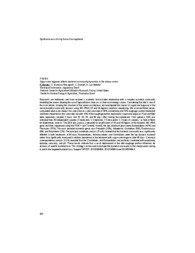Sugar cane bagasse affects bacterial community dynamics in the sheep rumen.
Sugar cane bagasse affects bacterial community dynamics in the sheep rumen.
Autoria: MENDES, R.; ROMAGNOLI, E. M.; DUNLAP, C.; ABDALLA, A. L.
Resumo: Ruminants are herbivores and have evolved a symbiotic host-microbe relationship with a complex microbial community inhabiting the rumen allowing the use of lignocellulosic biomass as their main energy source. Considering that diet is one of the main drivers shaping the structure of the rumen microbiome, we investigated the impact of sugarcane bagasse in the rumen bacterial community dynamic using 16S rRNA (V3 and V6 regions) amplicon sequencing. We assessed three rumencannulated adult male sheep (Ovis aries) fed on a diet consisted of 30% concentrate and 70% roughage (control treatment) and three sheep fed on the same diet, but with 14% of the roughage portion replaced by sugarcane bagasse. Fluid and fiber were separately sampled 3 hours and 15, 30, 45, and 60 days after starting the experiment. Total genomic DNA was extracted from 60 independent samples (2 treatments X 3 replicates X 5 time points X 2 types of samples, i.e. fluid or fiber) for downstream analysis. The DNA was used as a template for amplification of V3 and V6 regions of the bacterial 16S rRNA gene and then sequenced using the PGMTM (Ion Torrent). Overall, the two dominant phyla were Bacteroidetes (42%) and Firmicutes (37%). The most abundant bacterial genus was Prevotella (20%), followed by Clostridium (9%), Ruminococcus (8%) and Butyrivibrio (2%). The principal coordinate analysis (PcoA) showed that the bacterial community was significantly different in both treatments at 60 days. Bacteroidales, Actinomycetales and Clostridiales were the top dynamic bacterial orders that significantly increased in relative abundance in the treatment with sugar cane bagasse after 60 days. Canonical correspondence analysis (CCA) revealed that the Clostridiales and Bacteroidales are positively correlated with propionate, butyrate, ammonia, and pH. These results indicate that a small replacement in the diet roughage portion influences de dynamic of specific bacterial taxa. This strategy can be used to reshape the bacterial community in the sheep rumen aiming to enrich the targeted bacterial taxa. Support FAPESP 2012/03848-8, 2012/24588-4 and 2014/00448-4.
Ano de publicação: 2015
Tipo de publicação: Resumo em anais e proceedings
Unidade: Embrapa Meio Ambiente
Palavras-chave: Bactéria, Bagaço, Cana de açúcar, Rúmen
Observações
1 - Por padrão são exibidas publicações dos últimos 20 anos. Para encontrar publicações mais antigas, configure o filtro ano de publicação, colocando o ano a partir do qual você deseja encontrar publicações. O filtro está na coluna da esquerda na busca acima.
2 - Para ler algumas publicações da Embrapa (apenas as que estão em formato ePub), é necessário ter, no celular ou computador, um desses softwares gratuitos. Sistemas Android: Google Play Livros; IOS: iBooks; Windows e Linux: software Calibre.
Acesse outras publicações
Acesse a Base de Dados da Pesquisa Agropecuária (BDPA) para consultar o acervo completo das bibliotecas da Embrapa.

